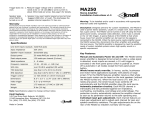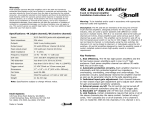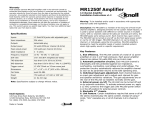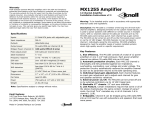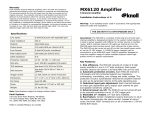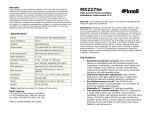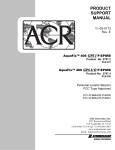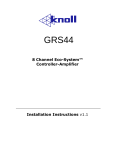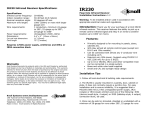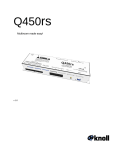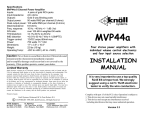Download Knoll 21K User's Manual
Transcript
21K Stereo amplifier specifications Inputs: Gold RCA jacks with adjustable gain Input impedance: 50k ohms Outputs: 5 way gold insulated binding posts Output power: 90 watts RMS per channel (8 ohms) Ideal impedance: 4 – 8 ohms Frequency response: 10 Hz – 40 kHz +/- 1dB S/N ratio: Over 106 dB A weighted (90 watts) THD distortion: Less than 0.1% 20 Hz to 20 kHz IMD distortion: Less than 0.01% 60 Hz 7 kHz 4:1 (SMPTE) Dimensions: 17” x 3.5” x 11.5” (432 x 89 x 292 mm) Fan noise: No fan needed Power: Maximum 320 watts at 117 VAC 60 Hz Weight: 20 lbs Construction: Steel chassis, powder coated; glass epoxy printed circuit boards Rack version: 21k-Rack Three Year Limited Warranty Knoll Systems warrants 21K amplifiers sold in the USA or Canada by authorized Knoll dealers to be free from defects in materials and workmanship. This warranty extends for three full years from the date of purchase by the consumer. Any products returned freight prepaid to Knoll Systems and found to be defective by Knoll Systems within the warranty period will be repaired or replaced at Knoll Systems option, at no charge. Knoll Systems will not be responsible for the actual cost of installation or removal of the product, nor for any consequential or incidental damages. Some states do not allow the exclusion or limitation of incidental or consequential damages, so the above limitation or exclusion may not apply to you. This warranty gives you specific legal rights. You may have additional rights, which vary from state-to-state. Knoll products sold outside of the USA and Canada may be covered by warranties provided by an authorized Knoll distributor. Please contact the distributor in the country that the Knoll product was purchased. Knoll Systems www.knollsystems.com 145 Tyee Drive Point Roberts, WA 98281 12140 Horseshoe Way Richmond BC V7A 4V5 Telephone (604) 272 4555, Fax (604) 272 5595 Made in Canada, © 2005, All Rights Reserved 21K Stereo Amplifier Installation Instructions v1.1 Caution: To reduce the risk of electrical shock, do not remove the cover (or back). No user serviceable parts inside. Refer to qualified service personnel. Warning: To reduce the risk of fire or electric shock, do not expose this appliance to rain or moisture. The lightning flash with arrowhead, within an equilateral triangle, is intended to alert the user to the presence of uninsulated “dangerous voltage” within the products that may be of sufficient magnitude to constitute a risk of electrical shock to persons. The exclamation point within an equilateral triangle is intended to alert the user to the presence of important operation maintenance (servicing) instructions in the literature accompanying the appliance. Important Safety Instructions: 1) Read these instructions. 2) Keep these instructions. 3) Read all warnings. 4) Follow all instructions. 5) Do not use this apparatus near water. 6) Clean only with dry cloth. 7) Do not block any ventilation openings. Install in accordance with the manufacturer’s instructions. 8) Do not install near any heat sources such as radiators, heat registers, stoves, or other apparatus (including amplifiers) that produce heat. 9) Do not defeat the safety purpose of the polarized or grounding-type plug. A polarized plug has two blades with one wider than the other. A grounding type plug has two blades and a third grounding prong. The wide blade or the third prongs are provided for your safety. If the provided plug does not fit into your outlet, consult an electrician for replacement of the obsolete outlet. 10) Protect the power cord from being walked on or pinched particularly at plugs, convenience receptacles, and the point where they exit from the apparatus. 11) Only use attachments/accessories specified by the manufacturer. 12) Use only with the cart, stand, tripod, bracket, or table specified by the manufacturer, or sold with the apparatus. When a cart is used, use caution when moving the cart/apparatus combination to avoid injury from tip-over. 13) Unplug this apparatus during lightning storms or when unused for long periods of time. 14) Refer all servicing to qualified service personnel. Servicing is required when the apparatus has been damaged in any way, such as power-supply cord or plug is damaged, liquid has been spilled or objects have fallen into the apparatus, the apparatus has been exposed to rain or moisture, does not operate normally, or has been dropped. 15).Under no circumstances should the output terminals of the amplifier be short-circuited. 16).Be sure that the loudspeakers connected can handle the output power of the amplifier at the loudspeakers rated impedance. The warranty on the amplifier does not cover damage to loudspeakers that have inadequate power handling capabilities. 17) Where an all-pole MAINS SWITCH is used as the disconnect device, the location on the apparatus and the function of the switch shall be described, and the switch shall remain readily operable; 18) A push button is used to turn the power off and on. 19) A LED is used to show when the apparatus is powered on. CAUTION: These servicing instructions are for use by qualified service personnel only. To reduce the risk of electric shock do not perform any servicing other than that contained in the operating instructions unless you are qualified to do so. Suggestion #3 Poor grounding of the electrical system in your home may also cause ground loop problems, particularly when there are multiple components with three prong, grounded, power cords. Unplug these components one at a time, and see if one or all of them is causing the problem. The ultimate solution to this type of problem is to rewire your house with an isolated, star typegrounding configuration. Knoll understands that this may be impractical and expensive. In some instances, the use of an approved AC Power Isolation Transformer (Knoll model PLB200) of sufficient capacity may solve this problem. Warning: If you suspect that the grounding system in your home’s electrical wiring is causing the hum problem, it is important that you do not make any changes to the wiring. Only a licensed electrician should make any changes to household wiring, and they must be made in full compliance with all local building, safety and electrical codes. Suggestion #4 Faulty earth grounds may also cause hum in your home’s electrical system. In the past, cold water pipes were often used for the earth ground, so it is important to make sure that your ground connection is working properly and has not become loose or corroded. The cold water pipe method may no longer be valid in some areas due to requirements that the water meter be isolated for the water mains with a length of PVC pipe, therefore interrupting the ground circuit. The safest and most reliable approach may be to provide your own ground. This can be accomplished by having a licensed electrician drive at least five feet of copper-jacketed steel grounding rod into the earth, and using that for your grounding connection. If the hum persists after all of the above suggestions have been tried, contact Knoll’s Technical Support department for assistance. Do not use this amplifier near water including near a bathtub, swimming pool or hot tub. This unit should be installed so that its location does not interfere with proper ventilation. For example, don’t place the amplifier on a bed, sofa, rug, or similar surface that may block the ventilation openings; or place in a built-in installation such as a bookcase or cabinet that may block the flow of air through its ventilation openings. The unit should be set away from heat sources such as radiators, heat vents, or other devices (including amplifiers) that produce heat. The unit should be connected to a power supply outlet only of the voltage and frequency marked on its rear panel. The power supply cord of the unit should be unplugged from the wall outlet when it is to be unused for a long period of time. Care should be taken so that objects to not fall, and liquids are not spilled, into the enclosure through any openings. The unit should be serviced by qualified service personnel when: • The power cord or plug has been damaged; or objects have fallen, or liquid has been spilled into the unit. • The unit has been exposed to rain, or liquids of any kind; or the unit does not appear to operate normally, or exhibits a marked change in performance. • The amplifier has been dropped, or the enclosure damaged. To prevent electric shock, do not use the polarized plug with an extension cord, receptacle or other outlet unless the blades can be fully inserted to prevent blade exposure. Introduction: Thank you for your purchase of a Knoll 21K stereo power amplifier and congratulations on your choice. This amplifier is specifically designed to be the best sounding amplifier available anywhere. Our engineers and designers spent years of pain staking research and testing to perfect the sound quality. We hope you will appreciate this effort and enjoy the amp. Unpacking: The carton and packing materials used in shipping your new amplifier were specially designed to protect it from the shock and vibration of shipping. We suggest that you save the carton and packing materials to use if you move, or if the unit ever needs to be shipped back to us for any reason. Should you discover that your amplifier has been damaged during shipping, please contact your dealer or Knoll immediately and request the name of the carrier so a written claim can be made. The right to a claim against a public carrier can be forfeited if the carrier is not notified immediately in writing and if the shipping carton and packing materials are not available for inspection by the carrier. Save all packing materials until the claim is settled. Placement During normal home operation the amplifier will become warm. However, there are instances during high-level playback into low impedance speakers when the amplifier will become much warmer than normal. To ensure the amplifier’s trouble-free operation, it is necessary to provide adequate ventilation. Your amplifier should be kept away from external sources of heat such as radiators and hot- air ducts. The amplifier should never be placed with other heat-producing components in a cabinet or enclosure lacking free airflow. Do not stack other components on top of your amplifier. Rack mounting A rack mount version of the 21K is available. For best operation when rack mounting the 21k we suggest it be near the top of the rack and have vented blank 1 rack space panels above and below the 21k. For multiple 21k amps in one rack we suggest spacing the amps 1 rack space apart and inserting a vented blank 1-rack space panel between each amp. Hum and noise Troubleshooting In most cases, one of the following suggestions should help you solve a hum noise in your system. Please try these steps in the order shown; proceeding from one step to the next if the prior suggestion does not eliminate the problem. Your Knoll amplifier is designed from trouble-free operation. If you follow the instructions in this manual, you should enjoy many years of high-quality listening enjoyment. However, as with any sophisticated device, there may be occasional problems upon initial installation, or during the life of the amp. The items on the list below are a brief guide to the minor problems that you may be able to correct yourself. If these solutions do not help, or if the problem persists, contact us for assistance. Potential ground loops in a complex A/V system Suggestion #1 To determine if a cable TV connection is responsible for the hum, first turn off all the components. Disconnect the cable TV feed to your system at the first place where it connects to your components. Alternatively, disconnect the cable TV wire where it is connected at the wall outlet. Turn your system back on, and listen if the hum has disappeared. If removing the cable TV feed has eliminated the hum, you will need to insert a Ground Loop Isolator our model GB634) before reconnecting the cable TV feed, or contact your cable TV operator to see if they can better isolate your cable feed. Suggestion #2 Turn off all components in your system, and then disconnect the input cables at the amplifier. Turn the amplifier back on to see if the hum is still present. If the hum disappears, the fault may be in the input cables used. Try replacing them with cables that have better shielding, and make certain that the input cables are not running on top of any AC power cords. Change the cables one at a time to determine if one or all cables are responsive. If the hum disappears when the input cables are disconnected, but returns after the cables are changed and the system reconnected, your source device may be causing the problem. Problem Solutions Amplifier won’t turn on Master power switch turned off (No power light LED). Turn on Master Power Switch. Amplifier won’t turn off Remote trigger cable not properly connected. Verify connection of trigger cable at both ends. Amplifier turns on, but no audio from one or more channels Input plugs not connected to proper jack or are loose. Check input connections. No audio from one or more channels Speakers are not connected properly. Check speaker connections at amp and speaker. Audio levels differ from source device. Improper settings or output levels Check the settings on your preamp, processor or controller. Also verify settings of the rear panel gain controls on your amp. Audio plays and then cuts off Amplifier may be shorted. Check speaker connections for short-circuit at amp and speaker. Input connections Getting to know the rear panel A. Audio Inputs Use the INPUT jacks to connect the outputs of a preamplifier, receiver with pre-out connections, CD player, or other control devices. B. Input Gain Controls Use these to adjust the input gain of each channel. C. Product Serial Number Write this number in the space provided on page “” for future reference. D. Remote Trigger Input Use the REMOTE TRIGGER jack to connect a compatible preamplifier, source device, or other product with a 12VDC output (abut 35mA required). E. Audio Outputs This is an unbuffered line level output to other devices such as another 21k amplifier. F. AC Input Use the included power cord to connect your amplifier to an AC power source. G. Speaker Outputs Use the OUTPUT binding posts to connect the amplifier to your speakers: red for positive, black for negative. Connecting your amplifier When making connections between any source components and the amplifier, or when making connections to any speaker, be certain that both the input devices and the amplifier are turned off. Unplug all equipment before making any connections so that there will be no unwanted signal transients that can damage equipment or speakers. Connecting the 21K to your source equipment is straightforward. Using the high-quality audio interconnect cables, match the output channel designations on the rear of your source equipment to the input jacks on the rear panel of your amplifier that have the same channel name. When making connections with RCA type plugs on interconnect cables, make certain to gently, but firmly, insert the plug into the jack. Loose connections can cause intermittent sound and may damage your speakers. Some quality RCA plugs may be very tight, and it is important to secure a proper connection between the interconnection cable and the input jack. Speaker connections To ensure that the high quality signals produced by your amplifier are carried to your speakers without loss of clarity or resolution, Knoll advises that you use high-quality speaker wire. Many brands of wire are available — the choice may be influenced by the distance between your speakers and the amplifier, the type of speakers you use, personal preferences, along with other factors. Regardless of the brand or type of speaker wire chosen, we suggest that you use a wire constructed of fine, multi-strand copper with a gauge of 14 or less (the lower the number, the thicker the cable). Wire with a gauge of 16 may be used for short runs of less than 12 feet. We do not recommend that you use any wires with an AWG equivalent of 18 or higher due to the power loss and degradation in performance that will occur. To connect the amplifiers to your speakers, a pair of binding posts is provided for each channel output. These posts will accept bare wire, spade lugs, or banana type plugs. If bare wire is used for the connections, strip approximately 1/2 inch to 3/4 inch of insulation from the end of each wire and carefully twist the strands of each conductor together. Be sure not to cut the individual strands or twist them off. All strands must be used for optimal performance. Correct polarity connections are important to maintain proper speaker phasing. When speaker phasing is correct, all speakers move in and out at the same time preserving the imaging of the program material. Out-of-phase connections mean that some turn off, check your speakers to verify that they are operating properly. If all other potential sources of trouble check out properly, contact Knoll for further assistance. Knoll Systems service information The 21K amplifier does not contain any user serviceable parts inside. If you suspect a problem that may require servicing, contact us at www.knollsystems.com/contact.html, or by phone at 800 566-5579. It is extremely important that only an authorized service dealer make any repairs. This will ensure proper service and preserve the protection of your warranty. Keep your receipt in a safe place so that it will be available to verify the purchase date, should you experience a problem covered by Knoll System’s warranty. Care, maintenance, and cleaning When the 21k amp becomes dirty, wipe it with a clean, dry, soft cloth. If necessary, first wipe the surface with a slightly dampened soft cloth with mild soapy water, then with a fresh cloth dampened with clean water. Wipe dry immediately with a dry cloth. NEVER use benzene, thinner, alcohol, or any other volatile cleaning agent. Do not use abrasive cleaners, as they will damage the finish of the metal parts. Avoid spraying insecticide, waxes, polishing agents, or any aerosol product near the 21K. 21k Automatic on Make certain that the connection to the controlling device is correct. Whenever the controlling device is turned on, the amplifier will automatically turn on after a short pause. This pause is intentional and it protects your speakers from damage while the amplifier stabilizes. You may also hear a relay click during start up. This is also normal. To turn off your amplifier, just turn off the device feeding the amplifier its audio signals. The amplifier will automatically turn off, which takes a few moments. Gain controls Level adjustments may be made at the rear of the amplifier. The circuitry in your new amplifier may be different from your previous one. Check the output levels to make sure that the control device amplifier and speakers are properly matched. Adjust these controls carefully as they operate in conjunction with the volume control(s) on your source device. Turn down the volume control(s) on the source device before adjusting the controls on the amplifier. AC line connector and power cord Warning: Under no circumstances should the round third prong on the plug be cut, bent or in any other way defeated as this may result in severe shock. Always turn off the amplifier and unplug the power cord before making any electrical connections. Protection circuitry Your Knoll amplifier uses an advanced protection circuit. The output will be cut off if excessive low frequency (below 10 Hz) is present, if the amp over heats or has excessive current demands. The amplifier will begin to operate normally after the over heating or excessive low frequency. Should this occur, check all speaker wire connections, both at the speaker terminals on the back of the amplifier to make certain that none of the strands from any channel touch another channel, and that none of the strands from a “positive” terminal touch strands from a “negative” terminal. Even a few stray wires can cause the amplifier to go into the protection mode. After checking all speaker connections, turn the unit back on. If it continues to speaker cones will be moving in, while others move out. This will cause indistinct or confusing imaging, and muddled and cloudy sounds. To avoid incorrect phasing or polarity, be sure to use wire that has distinct markings, colors, stripes, wording, or grooves on each side of the speaker cable. When making connections to the amp and speakers, follow a consistent pattern of using one side of the wire to the red terminals and the other side to the black. When using cable with markings on one side only, standard convention is to consider the marked side of the wire as the red, or positive (+) connection, and the non-marked side as the black or negative (-) connection. Next loosen the knobs of the amplifier’s speaker output terminals far enough so that they pass through hole is revealed. Follow the proper connection instruction for your system with regard to which terminals are used. Once the connections are made, twist the cap back so that the connection is secured but do not over tighten or use tools, as this may break the delicate wire strands and decrease system performance. If you are using spade lugs, connect them to the speaker wire using the manufacturer’s instructions, and then loosen the caps on the speaker terminals. Place lugs between the plastic cap and the back of the terminal. Be sure to observe proper polarity. Use your fingers to tighten to obtain a positive contact. When using banana plugs, connections may be made by inserting the jack affixed to your speaker wire into the hole provided on the rear of the colored screw caps on the binding posts. Before using banana –type jacks, make certain that the plastic screw caps are firmly tightened down by turning them in a clockwise direction until they are snug against the chassis. This ensures that the maximum surface area of the plug is in contact with the jack. Watch for proper polarity. Run the cables to speaker locations. Do not coil any excess cable, as this may become an inductor that creates frequency response variations in your system. Lastly, connect the wires to the speakers, again being aware of proper polarity. Remember to connect the negative, or black wire, to the matching terminal on the speaker. The positive or red wire should be connected to the matching terminal on the speaker. Note: While most speaker manufacturers follow industry convention of using red terminals for positive connections and black terminals for negative, some manufacturers may vary from this configuration. To ensure proper phase connections, and optimal performance, consult the identification plate on our speaker terminals, or the speaker’s manual to verify polarity. Contact the speaker’s manufacturer if you do not know the polarity of your speakers. Making rear panel connections When connecting the amplifier to your source equipment, match the output channel designations on the rear of your source equipment to the input jacks on the rear panel of your amplifier that have the same channel name. Correct polarity connections are important to maintain proper speaker phasing. When making connections to the amp and speakers, follow a consistent pattern of using one side of the wire to the red terminals and the other side to the black terminals. Power control connections The 21k amplifier features a built-in remote turn-on system that can automatically switch the amplifier on when another device in the system is switched on. Remote turn-on using products equipped with a lowvoltage trigger jack: Make sure the 21k front panel power switch is in the out of “OFF” position. Use an accessory cable with a 3.5mm mono mini-plug on each end to connect the trigger output jack on the rear of the source device to the trigger input jack on the back panel of the amplifier. The trigger needs to be 12 VDC and about 35 mA. When trigger power is switched on, the amplifier will automatically turn on at the same time. Remote turn-on using external AC to DC power converter: If your source device does not have a dedicated trigger jack, it is still possible to activate the unit for automatic turn on when a Switched Outlet is available on the rear of the source device. To control the 21k amplifier this way, you will need a small AC to DC power converter like our PS1202, capable of delivering 12 volts DC and over 35 mA. The DC voltage should terminate in a standard 3.5mm type mini plug (this will have to be added to the PS1202). This type of converter may be obtained as a power adapter from many electronic retailers. When installing, make sure the 21k front panel power switch is in the out or “OFF” position. Plug the DC adapter into a switched outlet on the source device that will be activated when you want to have the amplifier turn on. This may be the switched outlet at the rear of an AC receiver or other audio equipment. Connect the 3.5mm mini-plug from the adapter to the trigger-input jack on the back panel of the amplifier. The amplifier now turns on and off automatically, based on the status of the controlling device. Power connection Once all audio system connections have been made, connect the supplied power cord to the amplifier first, and then connect it to an AC power source. Please make certain that the amplifier is turned off and that the device connected to the remote trigger input is off when connecting the power cord and plugging it into an AC outlet. IN + O UT Speakers R BRI DGE Ga in (OU T) 1 2 VDC 45 mA Tri gg er In put Le ft L 21K R ight L R High Current Power Amplifier Power 8 A 12 0 VAC ~ 6 0 Hz 2-16 OHM SPEAK ERS Power connection. Observe correct voltage. Bridge switch must be in OUT postion. S OURC E Connect speakers to RED terminals. Minimum speaker impedance is six (6) ohms. + - Bridge Mode The 21K can be put into the mono bridge mode to increase the power output. To do this, first make sure the 21K is powered down or off. Speaker damage could occur if it is powered up. Amplifier operation Connect the source RCA jack to the left input. The left RCA source output can be sent to another amplifier input. After all connections have been made you are ready for operation. First, turn on the source component in your system. Make sure the bridge switch is in the out position. It is always a good idea to turn on your amplifier LAST. This avoids the possibility of any turn on pops or transients from other equipment being amplified and sent to your speakers where they may cause damage. Always start with a low volume level on your computer or preamp to avoid damage to your speakers. 21k Manual on Press the 21k front power switch to the “on” position. There will be a short pause from the time the power is turned on until power is applied to the speakers. This is intentional and protects your speakers from damage while the amplifier stabilizes. The red protect lamp will glow and when the amp is ready a blue light will switch on. To turn the unit off, press the power button again (out position). The amp will turn off in a few seconds. Connect the speaker (minimum 6 ohms) to the two red speaker terminals on the 21K. The left red terminal on the 21K is connected to the speaker positive (+) input. The black 21K speaker terminals are not connected in the bridge mode. Turn the Left gain on the 21k all the way down (counter clockwise). Turn the source on and the power to the 21k and adjust the Left gain as desired. Enjoy.








